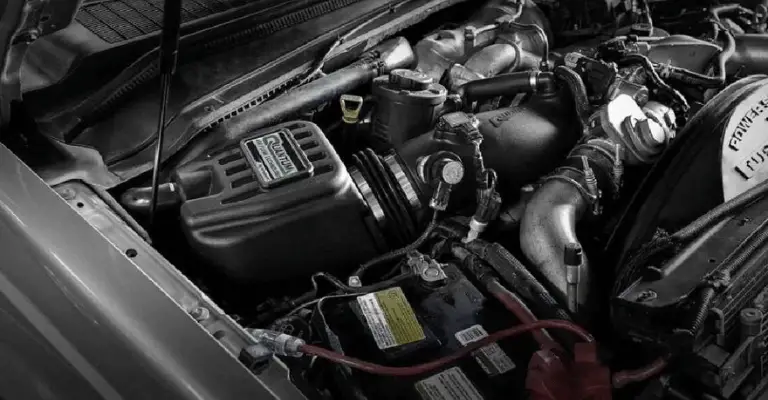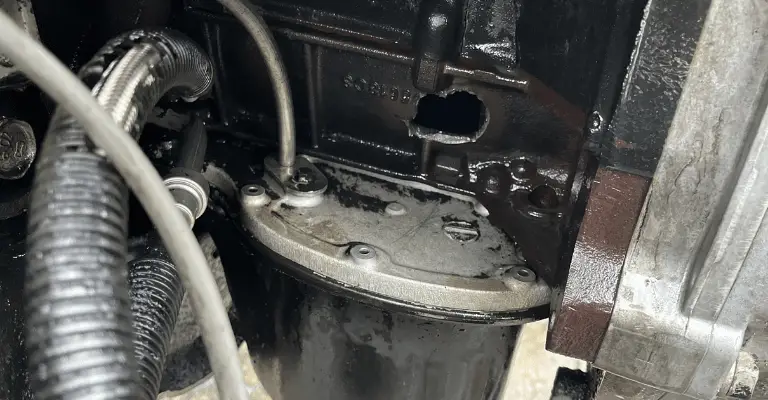Avoid turning your reliable 6.4 Powerstroke into a nightmare due to hidden problems. Equip yourself with the necessary knowledge to handle any challenges when they emerge.
Need tools for your project? Toolbox, a tool rental marketplace, might be worth a look.
This comprehensive glossary of common 6.4 Powerstroke problems is your go-to troubleshooting handbook, designed to empower you to handle unexpected hiccups with confidence and finesse. Get ready to delve into problem definitions, symptoms, causes, and, most importantly, practical fixes.
Keep this guide at hand and fear no engine trouble. Pre-empt, prepare, and protect your performance powerhouse with this in-depth breakdown that combines expertise and actionable advice – all in one handy resource. Your indomitable 6.4 Powerstroke’s wellness journey begins here. So what’re you waiting for? Let’s get to it!

Which Years of Ford’s 6.4 Diesel Engine are Affected?
The 6.4 Powerstroke engine was used in Ford’s F-250 to F-550 Super Duty trucks from mid-2007 to 2010. Over this period, a variety of issues arose, often related to the engine’s emission control systems, which underwent significant changes due to stricter emission laws. Unfortunately, the problems with this engine didn’t end there.
What Are The Most Common 6.4 Powerstroke Problems?
Let’s delve into the most common problems experienced by owners of Ford’s 6.4 Powerstroke diesel engine.
Fan Clutch Problems
The fan clutch in the 6.4 Powerstroke engine can encounter issues such as sticking or failing to engage. This can lead to overheating, especially during heavy towing or hot weather. Regular maintenance and using high-quality replacement parts can help prevent fan clutch problems.
Details
Regular maintenance and the use of high-quality replacement parts can help prevent fan clutch problems. Ensuring the fan clutch is functioning properly is essential for preventing overheating issues, especially in demanding conditions.
Fuel Rail Pressure Sensor Problems

The fuel rail pressure sensor in the 6.4 Powerstroke can fail, causing hard starting, rough idle, or even engine stalling. Regular sensor checks and timely replacements can help keep this issue at bay. A malfunctioning sensor can disrupt the fuel delivery process, affecting the engine’s overall performance and drivability.
Lift Pump Problems
The lift pump, responsible for supplying fuel to the high-pressure fuel pump, can fail in the 6.4 Powerstroke. This can cause low fuel pressure, affecting the engine’s performance.
Details
Regular inspection and maintenance of the lift pump are crucial to prevent low fuel pressure issues. Addressing lift pump problems promptly helps maintain consistent fuel delivery to the high-pressure pump, ensuring optimal engine operation.
Thermostat Problems
Thermostat problems can cause the 6.4 Powerstroke to overheat or have difficulty reaching operating temperature. Regular thermostat checks and replacements can help prevent these issues. A malfunctioning thermostat can disrupt the engine’s temperature regulation, potentially leading to overheating and subsequent engine damage.
Did you know you can stay ahead of these issues with an OBD2 scanner? OBDLink MX+ vs LX vs CX: Review & head-to-head comparison
What Other Issues are Found in Ford’s 6.4 Diesel Engine?
Besides the above, the 6.4 Powerstroke has several other common issues that owners should be aware of.
Oil Dilution
Oil dilution, where diesel fuel mixes with engine oil, is a common problem in the 6.4 Powerstroke. This can lead to inadequate engine lubrication, causing premature wear and tear.
Details
Regular oil changes using high-quality oil are essential to mitigate the issue of oil dilution. Addressing this problem is crucial for maintaining proper engine lubrication and prolonging the engine’s lifespan.
Cracked And Leaky Radiators
The 6.4 Powerstroke is notorious for radiator problems, mainly due to the factory design. The radiators can crack or leak, causing coolant loss and overheating.
Details
Replacing the factory radiator with a high-quality aftermarket part can effectively resolve radiator issues. Ensuring a reliable radiator is crucial to prevent coolant leaks and maintain proper engine temperature.
Intermittent DPF Issues
The Diesel Particulate Filter (DPF) on the 6.4 Powerstroke can cause intermittent issues, including clogging, leaking, and sensor failure. These problems can be costly and difficult to fix, often requiring replacement of the DPF system. Aftermarket DPF systems are generally more reliable than factory versions.
Brittle Up-Pipes
The turbo up-pipes in the 6.4 Powerstroke can crack, leading to loss of power and excess soot in the engine compartment.
Details
Replacing the brittle factory up-pipes with durable aftermarket parts is the recommended solution. Addressing this problem is crucial for maintaining engine performance and preventing soot-related issues.
Dwindling Miles Per Gallon (Fuel Economy)
The 6.4 Powerstroke is not known for its fuel economy, particularly in city driving.
Details
Aftermarket performance parts and regular maintenance can help improve the fuel efficiency of the 6.4 Powerstroke. Managing fuel economy can contribute to reducing overall operating costs.
EGR Coolers Prone to Clogging
The 6.4 Powerstroke uses two EGR coolers to reduce exhaust gas temperature, which can clog over time.

Details
Using a coolant filtration system can extend the life of the EGR coolers by preventing clogging. Maintaining these coolers is essential for proper exhaust gas management and overall engine performance.
Sensitive High Pressure Fuel Pump Wiring
The wiring for the high-pressure fuel pump in the 6.4 Powerstroke can be sensitive, causing issues with fuel supply and engine performance.
Details
Regular checks and proper maintenance of the high-pressure fuel pump wiring can prevent these problems. Ensuring reliable wiring is crucial for consistent fuel delivery and optimal engine operation.
Fuel-Water Separator Sensitivity
The 6.4 Powerstroke’s fuel-water separator can be sensitive, potentially causing performance issues.
Details
Regular maintenance of the fuel-water separator is important to maintain its functionality. Addressing this issue helps ensure proper fuel filtration and prevents potential performance disruptions.
Prone to Cracking Pistons
The 6.4 Powerstroke’s factory pistons can crack, leading to severe engine damage. Symptoms of piston failure can include excessive white smoke, compression loss, loss of power, and misfires.

Details
Replacing the factory pistons with high-quality aftermarket alternatives is the recommended solution to prevent severe engine damage. Addressing piston issues promptly is crucial for preventing further engine complications.
P.S. you may need an adapter for an OBD2 scanner: Torque Lite vs. Pro vs. DashCommand
6.4 Diesel Engine Community Reviews
In the Ford diesel engine community, the 6.4 Powerstroke is lauded for its raw power and potential for customization, but its common problems are also widely acknowledged. Many owners report that with proper maintenance and the right aftermarket upgrades, the 6.4 Powerstroke can be a reliable and high-performing engine.
Count on high-quality aftermarket parts and regular maintenance to keep your 6.4 Powerstroke running smoothly. Remember, every engine has its quirks and potential issues. The key is to understand them and address them proactively to ensure longevity and reliable performance.
Read more: OBDlink MX+ vs BlueDriver vs FIXD: Are they scams?
Are These Problems Enough to Stay Away from the 6.4 Powerstroke?
While the 6.4 Powerstroke engine has gained both praise and criticism, it’s important to weigh the issues against its potential. While the engine is not immune to a range of common problems like fan clutch issues, fuel rail sensor malfunctions, and radiator challenges, it’s worth noting that many of these concerns can be addressed with proper maintenance and the use of high-quality aftermarket parts.
Understanding that every engine has its quirks and potential problems, it’s not necessarily a reason to avoid the 6.4 Powerstroke altogether. In fact, many owners in the Ford diesel engine community report that, with attentive care and the right upgrades, the 6.4 Powerstroke can offer impressive power and performance, making it a reliable and high-performing choice.
Investing in regular maintenance, using quality replacement parts, and staying informed about potential issues can go a long way in ensuring the longevity and dependable performance of your 6.4 Powerstroke engine. As with any machinery, awareness and proactive measures are key to enjoying the benefits while mitigating the challenges.
General Maintenance Schedule To Help Prevent These Issues
| Maintenance Task | Mileage/Time Interval |
|---|---|
| Change engine oil and filter | Every 3,000 to 5,000 miles |
| Check and top up fluid levels | Every 3,000 to 5,000 miles |
| Inspect tires and adjust pressure | Every 3,000 to 5,000 miles |
| Check/replace air filter | Every 3,000 to 5,000 miles |
| Lubricate chassis components | Every 3,000 to 5,000 miles |
| Rotate tires | Every 15,000 to 20,000 miles |
| Inspect and clean EGR valve | Every 15,000 to 20,000 miles |
| Check/tighten belts and hoses | Every 15,000 to 20,000 miles |
| Inspect fuel filter | Every 15,000 to 20,000 miles |
| Inspect/clean DPF and DOC systems | Every 15,000 to 20,000 miles |
| Test/replace fuel filter | Every 15,000 to 20,000 miles |
| Inspect/replace serpentine belt | Every 30,000 miles |
| Inspect/clean EGR cooler | Every 30,000 miles |
| Check/replace water pump | Every 30,000 miles |
| Replace transmission fluid/filter | Every 60,000 miles |
| Inspect/clean EGR system | Every 60,000 miles |
| Check/replace fuel filters | Every 60,000 miles |
| Test/replace fuel injectors | Every 60,000 miles |
| Inspect/replace cam/crank sensors | Every 60,000 miles |
| Comprehensive annual inspection | Annually |
| Check battery condition | Annually |
| Inspect drive shaft/U-joints | Annually |
| Inspect radiator/hoses/clamps | Annually |
| Inspect/clean turbocharger | Annually |
Be aware that these are my personal suggestions and how I would treat my own truck. These do not align exactly with Ford’s recommendations. Unless you have experience to lean on, I recommend following Ford’s recommended intervals precisely.
FAQs and Related Questions
The engine frequently encounters issues like fan clutch problems, fuel rail pressure sensor malfunctions, lift pump failures, and thermostat troubles that can affect performance and reliability.
Oil dilution, where diesel fuel mixes with engine oil, can result in insufficient lubrication, premature wear, and potential damage. Regular oil changes and high-quality oil can help manage this concern.
The engine is known for radiator problems such as cracks and leaks. Upgrading the factory radiator to a premium aftermarket version can effectively resolve these issues.
To improve fuel economy, consider using aftermarket performance parts and maintaining regular upkeep, which can contribute to maximizing the engine’s fuel efficiency.